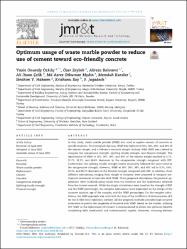Optimum usage of waste marble powder to reduce use of cement toward eco-friendly concrete
Citation
ÖZKILIÇ, Yasin Onuralp, et al. Optimum usage of waste marble powder to reduce use of cement toward eco-friendly concrete. journal of materials research and technology, 2023, 25: 4799-4819Abstract
In this study, waste marble powder (WMP) was used to replace cement of concrete in specific amounts. To accomplish this aim, WMP was replaced at 10%, 20%, 30%, and 40% of the cement weight, and a reference concrete sample without WMP (REF) was created to compare the compressive strength, splitting tensile strength, and flexural strength. The replacement of WMP at 10%, 20%, 30%, and 40% of the cement weight resulted in 5.7%, 21.7%, 38.1%, and 43.6% decreases in the compressive strength compared with REF. Furthermore, the splitting tensile strength results commonly followed the same trend as the compressive strength. However, WMP at 10%, 20%, 30%, and 40% led to 5.3%, 8.6%, 19.4%, and 26.7% decreases in the flexural strength compared with REF. In addition, three different calculations, ranging from simple to complex, were proposed to compute mechanical resistances of concrete with WMP. These proposed calculations for practical applications were validated using values from the literature and the implications obtained from the current research. While the simple calculations were based on the strength of REF and the WMP percentages, the complex calculations were dependent on the design of the concrete mixture, age of the samples, and the WMP percentages. For the complex calculations, the ANN approach was used with the help of the coefficient of determination (R2) for the K-fold cross validation method. All the proposed methods provided high accurate estimation to predict the properties of concrete with WMP. Based on the studies, utilizing 10% WMP as the replacement of cement is recommended to obtain the optimum benefits considering both mechanical and environmental aspects. Moreover, scanning electron microscope (SEM) and energy dispersive X-ray (EDX) analyses were then conducted to observe the interaction of WMP in concrete. According to the SEM analyses, some pores were detected and the interfacial transition zone was observed in the reaction zone. On the other hand, based on the EDX analyses, the presence of WMP in concrete was manifested by the presence of high levels of calcium.


















